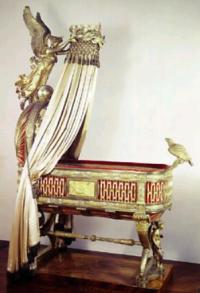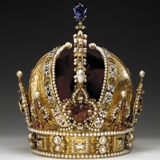The Cradle of the King of Rome (Napoleon II)
 As his first wife Josephine failed to produce an heir to the throne, Emperor Napoleon Bonaparte chose to divorce and to remarry Archduchess Maria Ludovika of Austria, daughter of Emperor Francis II/I, by proxy on 11 March 1810. Marriage by proxy means that Napoleon was not physically present at the ceremony in the Augustine Church (Augustinerkirche) in Vienna, but represented instead by another person - by Archduke Carl of all persons, who clearly defeated Napoleon one year earlier in the Battle of Aspern!
As his first wife Josephine failed to produce an heir to the throne, Emperor Napoleon Bonaparte chose to divorce and to remarry Archduchess Maria Ludovika of Austria, daughter of Emperor Francis II/I, by proxy on 11 March 1810. Marriage by proxy means that Napoleon was not physically present at the ceremony in the Augustine Church (Augustinerkirche) in Vienna, but represented instead by another person - by Archduke Carl of all persons, who clearly defeated Napoleon one year earlier in the Battle of Aspern!
Napoleon's political intention for this marriage was to strengthen the legitimacy of his Empire, Austria for its part wanted to secure the political interests of the Habsburg Empire. In addition Napoleon remarried in search of a male heir. His ardent wish was fulfilled on 20 March 1811, when Maria Ludovika - in the meantime commonly referred to as "Marie Louise" - gave birth to a healthy boy, who was baptized Napoleon Francis Carl.
On the day of his birth, Napoleon gave his ardently desired son the title "King of Rome", whereas he was widely known in France as "the Eaglet" ("l'Aiglon") - the "Son of the Eagle". After the defeat of Napoleon and his final exilation, the Congress of Vienna accorded the title "Duke of Reichstadt" to Napoleon's son. Interestingly, Napoleon Francis Carl is until today known by different names in the different countries of Europe: the French do mainly speak of him as "the Eaglet", Italians refer to him as "King of Rome" and Germans as "Duke of Reichstadt", while the most common designation in the anglo-saxon countries is "Napoleon II.".
However, the birth of an heir to the throne was a reason of great joy for Napoleon, and a big part of Europe celebrated with him. To honor the occasion, the city of Paris offered a throne cradle made of more than 280 kg of silver to the Empress Marie Louise. The iconographic program of the cradle emphasizes the achievements of Napoleon and expresses the hopes which were related to his son:
- the cradle stands on horns of plenty, symbols of good government and wealth
- force and justice are represented by two little angels
- the cradle is decorated with bees on all its sides, representing on one hand the diligence of the citizens of Paris and being on the other hand the personal emblem of Napoleon Bonaparte
- one side of the cradle shows - in allusion to the royal title of the newborn - the legendary Capitoline Wolf; the other side is dominated by a representation of Sequana, the goddess of the river Seine, referring to the loyalty of Paris to Napoleon Francis Carl
- a representation of the goddess of victory crowns the cradle with a laurel wreath and a star crown. The laurel wreath reminds of the French imperial crown used by Napoleon to incoronate himself. The star crown stands for the glory that France had acheived under the reign of Napoleon.
- the largest star of the crown bears the letter "N" for "Napoleon", who was said to be the brightest star shining upon France during his lifetime. On the footboard of the cradle, a little Eagle not yet able to fly raises his eyes towards this star, thus expressing the hope that Napoleon Francis Carl might one day acheive as much glory as his father.
If you wish to learn more interesting details about the cradle of Napoleon Francis Carl, we invite you to join our experts during a guided tour through the imperial treasury museum or to book a guided tour to Schönbrunn palace where the heir of Emperor Napoleon Bonaparte died on July 22nd, 1832.
